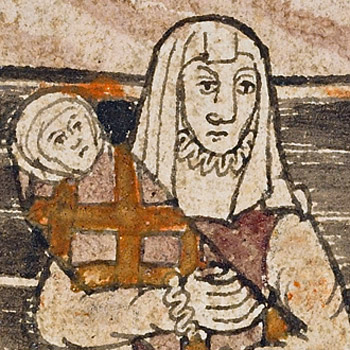King of Tars
General Information
Plot Summary

The Sultan of Damascus hears that the King of Tars, a Christian, has a beautiful daughter and demands her hand in marriage. The King is unwilling for his daughter to marry a pagan, and she will not renounce her faith, so the request is refused. The enraged Sultan gathers his troops and attacks the Christians, who are forced to flee. Seeing the misery that her refusal has caused, the princess persuades her unwilling parents to agree to the marriage. The Sultan is delighted and the princess sadly leaves her family’s court.
The couple are not immediately married, as the Sultan is unwilling to wed the princess until she accepts his faith. She spends her first night alone and is disturbed by dreams of black dogs and devils, but is comforted when one of the dogs transforms into a man and promises that Christ will save her. The next morning, she accompanies the Sultan to his temple, where he threatens to kill her parents if she does not convert. She agrees, kisses the idols and is instructed in his religion. Secretly, however, she remains Christian and continues to pray when she is alone.
The couple are married in a lavish ceremony and the princess falls pregnant. When she gives birth, however, the child is a lifeless lump of flesh, with no limbs, bones or facial features. The Sultan blames his wife for being insincere in her faith. She replies that if his gods can bring the lump to life, she will believe in them completely. He takes the child to the temple, but when his prayers have no effect he smashes the idols and returns disillusioned to his wife. There, he agrees that if, as she claims, her God can bring the child to life, he will become a Christian. A priest called Cleophas is found among the Sultan’s prisoners and is brought to the princess’ chamber, where he christens the lump after Saint John. During the ceremony, it miraculously becomes a beautiful child and begins to cry. The priest fetches the Sultan, who asks to be instructed in the faith.
The next day, as Cleophas baptises the Sultan, his skin changes from black to white, signifying the completeness of his belief. At his wife’s suggestion, the Sultan invites her father to help him convert his people. The King of Tars travels to Damascus with his army and is joyfully reunited with his daughter. Those Saracens who are willing are converted, the others are executed. Five Saracen kings declare war on the Sultan, but although their armies greatly outnumber the Christian host, they are overrun and their leaders are killed. Many of their prisoners agree to convert and are freed, the others are put to death. [The poem is incomplete.]
From: J. Perryman, ed., The King of Tars: Edited from the Auchinleck Manuscript, Advocates 19.2.1, Middle English Texts 12. Heidelberg: Winter, 1980.
Manuscripts
Click a title below to search for all romances in that manuscript.